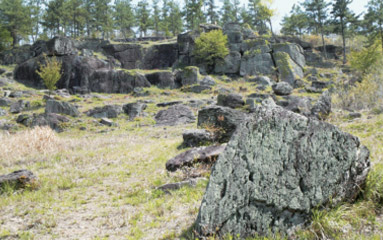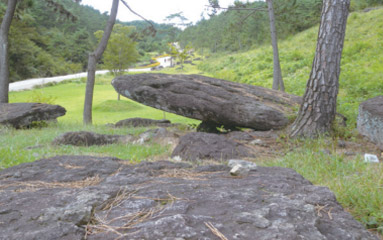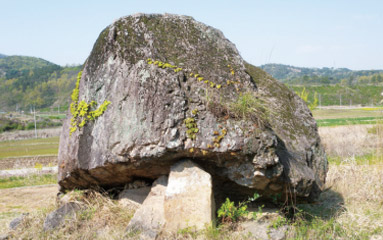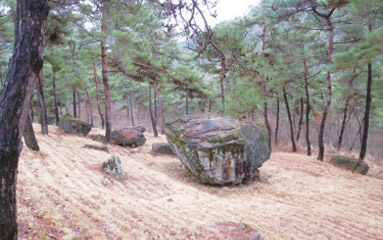
Dolmen ruins
Distribution
The rocks widely distributed in Daeshin-ri, Chunyang-myeon and Hyosan-ri, Dogok-myeon are composed of lava and are called rhyolitic tuff in their geological name. Tuff is a pyroclastic rock formed by the deposition and solidification of volcanic ash, and refers to volcanic emissions with a diameter of 2 mm or less. Lava is solidified after molten liquid magma erupts to the surface, and usually has very high fluidity. Joint walls are used for quarrying, and water enters between the grooves and accelerates weathering and erosion, resulting in collapse of rocks.
The stone that makes up the Hwasun Dolmen is lava and has many joint walls. The reason why Dolmens are collectively distributed in this place is that the stone is lava with a well-developed structure of plate joints. Hwasun Dolmens are distributed against the background of a wide flat area formed around the Jiseok River, a branch of the Yeongsan River. Dolmen are distributed one after another along the foot of the mountain in the south of this plain. These Dolmens appear all over the 4.5km-long distance across Mt. Manji (275m), Mt. Bogeomjae (188.5m), Mt. Pingmae Rock (215m), and Mt. Jobong (174m), from Hyosan-ri, Dogok-myeon to Daesin-ri, Chunyang-myeon. Bogeomjae is a hill belonging to Daesin-ri, but has been an important inland route connecting Boseong and Naju where people of Beolgyo and Boseong frequently used to go to Nampyung market since ancient times, also the slat merchant used. The current road was a traditional path when Dolmens were discovered in 1995, but a forest road was opened after a forest fire in the late 1990s, and was later completed as the current road.
The cultural heritage protection area is 250m long, with Jidong Village to the east and Mosan Village to the west, centered on Bogeomjae. Currently, it serves as a boundary between Dogok-myeon and Chunyang-myeon in Hwasun-gun, and a valley flows down from Bogeomjae to Jidong Village. The distribution of Dolmens is also found on the plains in front of villages and within villages, but most of them are clustered along the foot of the mountain. The small road that was previously used as a transportation route became a wide road (unpaved) for cars to pass by opening a forest road and an access road to the grave of the family of Yeoheung Min. So many Dolmens seem to have been damaged during the road construction.
The Dolmens in Daesin-ri, Chunyang-myeon are located between 65m and 125m above sea level, and the Dolmens in Hyosan-ri, Dogok-myeon are also distributed between 45m and 90m above sea level. In the Daeshin district, the ridges of narrow valleys seem to be tightly packed with Dolmens, while in the Hyosan district, large and small Dolmens are lined up in rows on the wide ridges, showing regional differences. According to a report in 1999, 596 Dolmens, including those presumed to be the cover stones of Dolmens, were identified among the buried or collapsed Dolmens in Hwasun, a World Heritage site. However, there were 21 Dolmens in Jidong Village in Daeshin-ri (Group A) at that time, but as a result of the excavation in 2000, 19 Dolmens were added to increase the number to 40 Dolmens, making total 615 Dolmens. Excluding presumed Dolmens, there are total 306 Dolmens, 148 units in the Daeshin district and 158 units in the Hyosan district (305 units excluding Baekje tombs). Meanwhile, there are 8 Dolmens in the Hyosan district, which is presumed to be a quarry, including 7 Dolmens (2 in F-group) and 1 site (group) in Daeshin-ri.
Characteristics
First
300 Dolmens are distributed in a high density in the 5km area of Bogeomjae Valley (Boseonggol), which connects Hyosan-ri and Daeshin-ri.
Second
Daeshin-ri, which has a huge cover stone, 7.3m long and 5.0m wide. A Dolmen with a thickness of 4.0m and a weight more than 200 tons. In Hisan-ri, more than 100 giant Dolmens with 5.3m long and 3.6m wide and 3.0m thick are distributed.
Third
You can see various types of Dolmens such as footing type, no-wheel stone type, and table type in one place.
In Gochang, so-called ground stone tomb type Dolmens with a table-type or similar cover stones were developed, but in Hwasun, a table-type Dolmen is presumed to have been transformed into no-wheel stone type Dolmen.Fourth
The quarry from which the cover stone of the Dolmen was removed was also investigated, and you can see the real education center where you can learn about the Dolmen construction process.
Fifth
The Dolmens are located between valleys and are in a relatively good state of preservation. Hwasun Dolmens are sparsely clustered along the foot of a valley that stretches for about 10 km. They were mostly located in the pine forest at the foot of the mountain without development. They were recently discovered and are in a very good state of preservation.
Sixth
The Dolmen's tomb room, artifacts, and construction date have been confirmed. At the Dolmen excavation site in Daeshin-ri, many relics such as ring wheels and arrowheads and various tomb rooms were discovered. Charcoal and ring wheels from Dolmens and earthenware excavated from the quarry revealed that the Hwasun Dolmens were built in the Early Bronze Age.
Seventh
It is true that there are Dolmens equipped with graveyard facilities with flat stones laid in an oval shape around the Dolmens.




